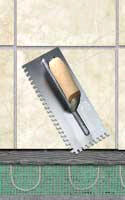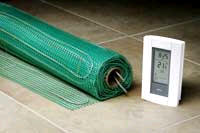There are so many beautiful flooring materials for bathrooms, kitchens, and family rooms, yet they all have a major drawback. They are cool and sometimes very cold to the touch. There is nothing much worse than stepping out of a relaxing hot shower onto an ice cold floor.
Materials such as laminate, ceramic and porcelain tile and even wood are always colder than the air in the room. The answer may be to place area rugs or runners over these areas, but that takes away from the appearance of the actual floor itself.
If the answer isn't area rugs, what is a rational alternative? The answer is radiant heating! Electric radiant heating can make most any floor warm and inviting.
More and more people are beginning to realize that a radiant underfloor heating system in the bathroom is becoming a must have, especially now, when almost all governments are asking us to lower the temperature in our homes to conserve energy. The advantage of radiant underfloor heating is that it provides heating of a specific small area, rather than heating an entire building in order to raise the temperature and provide a level of comfort in one room.

Figure 1 - Electric Heating wires embedded in thin set adhesive
For those who might be concerned about using a new product, that is untried and unproven, you should be aware that electric radiant underfloor heating has been used successfully for more than 10 years in North America.
While the use of electric underfloor radiant heating has become accepted in kitchens and bathrooms, under ceramic and porcelain tiles, it created a bit of a dilemma for use under carpets and laminate flooring. The problem or situation was that electric underfloor heating is manufactured as a mat with electric heating wires woven into it. The mat was designed to be embedded in a layer of thin set mortar adhesive (as shown in Figure 1), which works out well if you are installing a ceramic or natural stone tile, however as thin set mortar adhesive is not required in order to install laminate or carpet flooring, it became a major expense to use the product with those flooring materials.
Luckily we live in a world where products are continually being upgraded and enhanced and that is now the case with electric underfloor radiant heating. The Warmly Yours' Environ II electric underfloor radiant heating system has been approved, by UL, for use under laminate and carpet flooring materials without the need for a thin set adhesive mortar.
The mesh mat with its woven electric heating element and temperature sensor are placed on and then taped to the underlayment pad used as part of the installation of any laminate flooring material. The laminate flooring material is then laid directly on the mesh mat. Most handymen can perform the installation themselves. The electric heating element in the floor mat is then wired to a thermostat (see figure 2), mounted on the wall by an electrician. It uses a basic 110 VAC circuit.

Figure 2 - Mesh with radiant heat wire and thermostat
Electric radiant underfloor heating is very energy efficient. As previously mentioned, you are only heating a specific area, rather than a whole home. The mat itself provides additional insulation between the sub-floor and the finished floor, providing added comfort even when the heating is off.
Operationally, the average bathroom of approximately 120 square feet, would cost about 40 cents per day.
Electric underfloor radiant heat has additional features:
- 100% Silent: Unlike forced air there are no background noises.
- Energy Efficient: Underfloor heating distributes warmth more effectively than forced air allowing thermostats to be set to lower temperatures.
- Better Indoor Air Quality: Unlike forced air which spreads dust, dirt and pollen throughout a home, radiant heat does not distribute or recycle indoor air. This is especially important for family members with respiratory and allergy problems.
